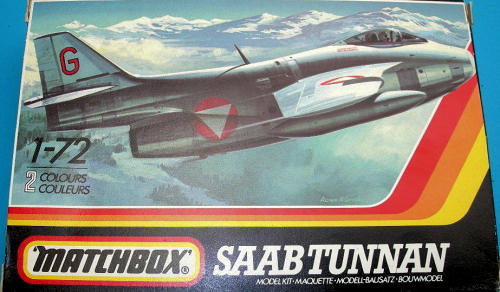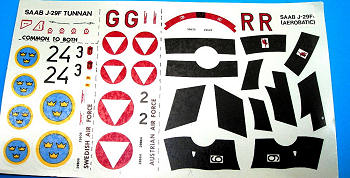Matchbox 1/72 Saab J.29F
|
KIT: |
Matchbox 1/72 Saab J.29F |
|
KIT #: |
PK-33 (1979) |
|
PRICE: |
Currently out of production |
|
DECALS: |
Three options |
|
REVIEWER: |
Victor
Scheuerman |
|
NOTES: |
|

In
1945 SAAB started work on Project R1001 which was to use the de Havilland GOBLIN
engine. However, later in the same year the more powerful GHOST was made
available and SAAB took the opportunity of redesigning the project to accept the
GHOST. The resultant aircraft, the J29, made its maiden flight in November 1948,
entering service as the J29A in May 1951. Development was rapid and the ‘E’
version, which introduced the ‘Dog Tooth’ wing leading edge, flew in December
1953. The final variant, the J29F was produced after the installation of the
engines with afterburners. J29F aircraft, with successive modifications to
enable more advanced missiles to be carried continued in service with great
success until 1973. (Thanks to the kit instruction sheet.)
 This
is an early Revell
Germany
boxing of this Matchbox kit so it was still produced in two colours and in this
case grey and a green-grey plastic. The kit has a total of 31 parts (30 in this
box read further) that includes a clear one-piece canopy. Matchboxes Flying
Barrel has a combination of both engraved (a little over done, but not too bad)
and raised panel lines. What is nice about this kit is that the fuselage is
fully engraved with just some of the panel lines raised on the wing. This is a
much better arrangement then their usual habit of engraving the flying surfaces
(that are easier to engraved because they are largely even surfaces) to the
raised panel lines on the fuselage that are more difficult to engrave.
This
is an early Revell
Germany
boxing of this Matchbox kit so it was still produced in two colours and in this
case grey and a green-grey plastic. The kit has a total of 31 parts (30 in this
box read further) that includes a clear one-piece canopy. Matchboxes Flying
Barrel has a combination of both engraved (a little over done, but not too bad)
and raised panel lines. What is nice about this kit is that the fuselage is
fully engraved with just some of the panel lines raised on the wing. This is a
much better arrangement then their usual habit of engraving the flying surfaces
(that are easier to engraved because they are largely even surfaces) to the
raised panel lines on the fuselage that are more difficult to engrave.
A
better then usual cockpit is offered that includes a basic tub with the ejection
seat molded in place, which then includes a control column and an instrument
panel with raised detail. A real pleasant surprise is the circuit panel on the
port wall with nicely done engraved detail. Add a harness and this cockpit is
good to go.
External
options are limited to the wing tanks and their unique shape is well
represented. All the gear bays are fully framed in and the large main wells have
the vertical ribs in place and as per normal for Matchbox all the gear doors
should be thinned to a more scale appearance. Finishing off the landing gear are
the legs and wheels and Matchbox did do a fine job on these as the legs are not
too thick and there is nice detail on the wheels. One thing noticed is that Part
33; the nose gear forward door with the landing lights was missing. A check of a
second kit showed the same problem.
The assembly of
this basic kit (not a bad thing) is covered in eight steps on the well drawn
diagrams. Detailed painting notes and drawings are offered at the end of these
and because this is a Revell boxing, there are diagrams showing where all the
decals are placed, except for one option. For some reason, the decal sheets
offers three options, but only two are covered in both the instruction sheet and
on the back of the box in full colour profiles. All three options are natural
metal with two being Swedish and the third aircraft is for the only foreign
operator of this;
Austria.
 Starting
with the SAAB J29F used by the 2nd Jabobomberstaffel, Austrian Air
Force. This fighter bomber has the national insignia in the normal six locations
with the aircraft letter ‘Red G’ on the tail. The latter has black piping around
this letter. The Swede that is covered in the instructions is from F3 Wing and
features the wing badge on the nose with a large black 24 on the vertical tail
and a smaller 3 on the fuselage. As
to the ‘mystery Swede’?
Starting
with the SAAB J29F used by the 2nd Jabobomberstaffel, Austrian Air
Force. This fighter bomber has the national insignia in the normal six locations
with the aircraft letter ‘Red G’ on the tail. The latter has black piping around
this letter. The Swede that is covered in the instructions is from F3 Wing and
features the wing badge on the nose with a large black 24 on the vertical tail
and a smaller 3 on the fuselage. As
to the ‘mystery Swede’?
Thanks
to my cherished Profile Publications
Number 36 The SAAB J29 (Bo Widfeldt), this is an aircraft of 1st
Wing, F9, that had black air exercise markings applied. These were wide black
bands that were applied to the main wings (two stripe per) and to the fuselage
(three). It has the unit’s red devil on the nose and ‘Red R’ outlined in black
on the tail. Not only is there a full colour profile of a sister ship (Red T) in
this 1965 profile, but a supplementary plan view showing the band locations on
the wings. While the kit supplied all of these as decals, I would think that
masking and painting maybe a better why to go. As to the quality of the decals?
As this is a Revell boxing they look quite good and are in perfect register.
Another
underappreciated subject that thankfully Matchbox (and Heller, currently Airfix)
produced. Simply adding a harness
to the seat and perhaps some card to represent a gunsight shape would certainly
upgrade the interior sufficiently. Thinning the gear doors, drilling out the
nose cannon shrouds and adding an intake guard would certainly be enough for the
exterior. Another weekend adventure in a box!
Victor
Scheuerman
July 2008
If you would like your product reviewed fairly and quickly, please
contact
me or see other details in the
Note to
Contributors.
Back to the Main Page
Back to the Previews Index Page


 This
is an early Revell
This
is an early Revell 